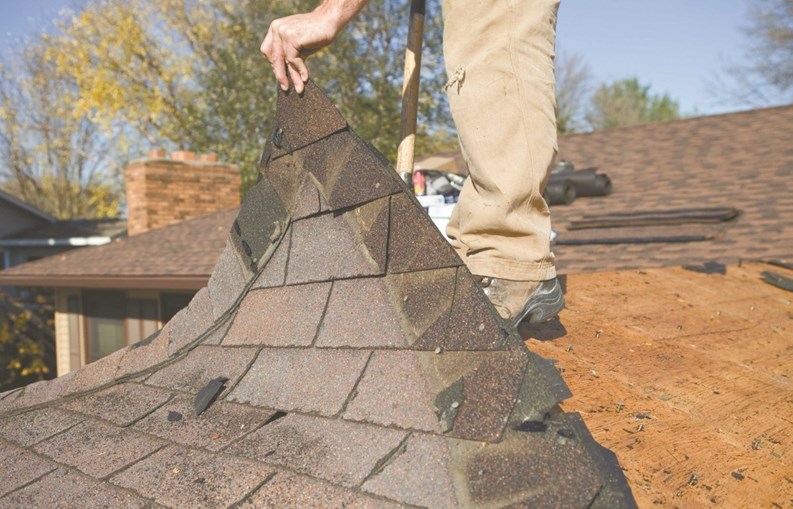Condo owners don’t generally exude enthusiasm over their roofs. In fact, they don’t pay much attention to them until there is a problem. However, a roofing problem can cause a major expense.
Roofs in New England condominiums break down to two categories: flat and pitched. Pitched roofs are constructed with shingles and flat roofs have either plastic or rubber material, referred to as a rubber membrane. There is also a mansard roof which has a shingled pitch around the perimeter and a flat surface in the interior
“The type of roof depends on the design of the building,” says Mike McDuffee, a project manager at Corolla Roofing, located in Winthrop, Massachusetts. Corolla re-roofs 8 to 10 condo buildings each year and does a lot of repair work, primarily in eastern Massachusetts as well as Worcester, Cape Cod and .New Hampshire. Most of the buildings average 30 units, but range up to 60 to 80 units in some cases. According to McDuffee, “a pitched roof with shingles is better for water runoff, but can be prone to buildup of ice dams. But if done correctly, it doesn’t matter if a roof is flat or pitched. It’s not cost effective to change from one to the other.”
New Materials and Practices
There have been a number of changes in roofing materials and practices in the last 15 to 20 years, the span in which most New England condos were built. “The rubber membrane for rubber roofs are made of a better grade and hold up longer,” according to Michael Pasquino, senior portfolio manager at Barkan Management Company, with offices in Boston, Connecticut, Rhode Island and Washington, D.C. “They have also made a better way of seaming the membrane,” says Pasquino, who manages six condos as well as several subsidized apartment buildings. “They also have rivets and ice shields so that if water gets in the rubber, the ice shield will absorb it. There are asphalt shingles for pitched roofs.”
In addition to better seaming, McDuffee points out there is also a plastic rubber hybrid which is fire retardant. Rubber roofs, he notes, are the way to go for flat roofs. “Nobody does tar and gravel anymore,” he notes. For pitched roofs, he says, there are now laminated architectural shingles that are thicker, heavier, easier to install and have curb appeal, in addition to new shingles that are resistant to green and black algae. Perhaps the biggest change for pitched roofs is the introduction of ridge vents. “They ventilate air space, get out the hot air, they’re not expensive and they add life to the shingles because they’re not getting heat from the bottom,” McDuffee explains.
Environmental consciousness and green technology have also impacted the roofing industry, according to Dean Secchiaroli, regional manager for Eagle Rivet Roof Services in Tewksbury, Massachusetts. Secchiaroli’s family was in the roofing business, and, he says, roofing is in his DNA.
“The bonding adhesives for flat roofs has what’s called a low VOC, or low amount of volatile chemicals,” notes Secchiaroli. “Although it is not a legal requirement in Massachusetts, a lot of associations use it because it is eco-friendly. However, it does give off strong odors. Some membrane roofs are white to reflect sunlight, for cooling in summer so that less air conditioning is needed.” His other observations: “Pitched roofs are often using shingles with different formulas so they reflect more light, getting away from black shingles. There also more solar panels on roofs, for heating to reduce winter energy costs. Insulation materials are getting thicker—more in Connecticut than Massachusetts, because power companies there are giving rebates for private residences.”
Insulation is Important
McDuffee says Massachusetts has requirements for insulation: “For every five inches of a roofing material called Poliso, there must be 30 inches of insulation material. This saves money on heating costs, plus you get energy credits.”
So what should a condo association do if there’s a roofing problem? If a new roof is needed, Pasquino advises the condos he manages to hire a consultant, and will provide the trustees with a list of recommended consultants. Both Secchiaroli and McDuffee agree. “Consultants will take bids from roofing companies with specifications,’ says NcDuffee. “That way you’re matching apples to apples so you can compare what you’re getting based on what you need.” McDuffee points out the worst mistake a board can make is to assume they have the expertise. “A consultant will look at not only the roofer but also the manufacturer he does business with,” he says. “A roofer has to be approved by a manufacturer, which requires a proven track record. The roofer has to give the manufacturer a pre-installation proof plan, which the manufacturer reviews and, if needed, revises. After completion, the manufacturer sends an inspector to make sure the work is done properly.”
“There is usually a two- to five-year warranty for workmanship,” says Secchiaroli. “Warranties for materials can range from 15 to 30 years.” McDuffee suggests a 15- to 20-year warranty and advises, “A properly maintained roof will last longer, so a 15 to 20 year warranty gives the best bang for the buck.” Secchiaroli cautions that warranties do not cover acts of God such as fallen trees from storms or problems from poor maintenance. “People tend to want to do a roof once and forget about it,” observes Secchiaroli. “In New England we have temperature changes from summer to winter, which can create changes in the roof.” He notes that when the old roof is torn off there can be unforeseen conditions such as asbestos or lead paint. “With good input, roofs can go 30 instead of 10 years,” he says.
Bob Burns of Burns Associates in Portsmouth, New Hampshire, is an engineer who works as a consultant to condo associations with multiple buildings. His two biggest and costliest projects are roofs and roadways. When hiring roofing companies, he also stresses the importance of setting up a bidding process “with specifications so that associations can compare apples to apples in choosing a roofing company.” In coming up with a design, he likes to troubleshoot and work at solving any problems. In working with a Nashua condo association with an indoor pool, he notes, one focus was on how the pool, in conjunction with the roof, could add energy conservation. “I made sure the roof had good insulation,’ notes Burns, “and also used the heat from the pool to heat the room to lower energy costs as well as reduce condensation on the walls.”
Making it Last
Burns also helps condo associations develop a capital assets and management plans, working with boards to determine all the things that will need to be done over a 20 to 30 year period. “We then come up with a schedule as to when each project will be done and how it will be financed so that the board doesn’t have to deal with more than one problem at a time,” says Burns. Unless there are sufficient reserves, financing is done either with special assessments or, if necessary, bank loans.
Not all condos, however, are large buildings with many owners. The three-family condominium presents a unique problem, according to McDuffee. “The guy on the third floor is the one closest to the roof so he’s getting the initial problems,” he notes. Unless the problem is affecting the other owners they may not want to pay for the necessary repair or replacement. “You have to educate people,” he advises.
Re-roofing is a big expense but there are ways to maintain the roof so that its life is prolonged.
This starts with the construction of the roof itself. “Condensation can lead to rot and mold,” Burns points out. “This is particularly true with condos that have cathedral or vaulted ceilings.” He emphasizes that having proper air flow is important. Building channels in the soffit area so cold air can escape out the roof will minimize condensation.
With flat roofs, a big problem is foot traffic, according to both McDuffee and Secchiaroli. Putting decks on roofs will increase foot traffic and lessen the life of the roof. Other amenities such as air conditioner units and cable and cell phone equipment also result in repair workers walking on the roof and sometimes forgetting and leaving equipment. Pasquino likes to have someone from the management company accompany repair people to minimize these problems.
The experts agree that a key to preserving the life of a roof—and the warranty—is an annual inspection. An inspection will discover problems like leaks, water buildup and improper drainage “The best time of the year to do this is the fall,” says McDuffee, “so that leaves can be swept away to prevent clogging and water buildup on the roof. It’s also before winter when snow cover makes inspection difficult.” Secchiaroli points out “a good roofing company will offer a five-year maintenance program.”
Leonard Golder is a freelance writer in Massachusetts.







Leave a Comment